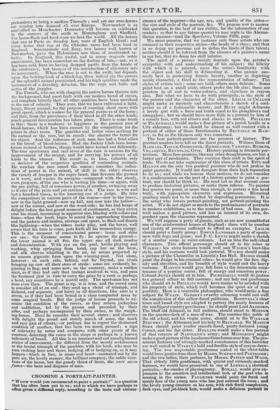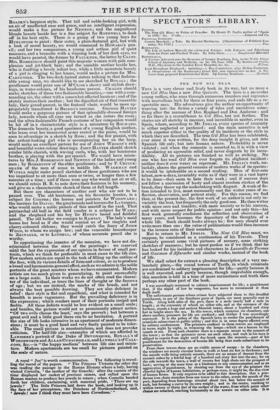CHOOSING A PORTRAIT-PAINTER.
WHOM would yen recommend to paint a portrait?" is a question that has often been put to us ; and to which we have perhaps as nften: given a diffeDant reply,, a.ecoading to the taste and -circum stances of the inquirer—the age, sex, and quality of the sitter— the size and style of the portrait, &c. We propose now to answer this question, to the best of our ability, for the information of our readers ; so that to any future querist we may reply in the Abernetheian manner—read the Spectator, Volume Fifth, page We must premise, that we instance only those artists who are eminent in their respective styles—the heads of a class ; and that in so doing we presume not to define the limits of their talent; neither should it be inferred from the absence of a painter's name in our list; that we deem his skill inferior.
The spirit of a picture mainly depends upon the painter's sympathy with and understanding of his subject; the felicity with which it is painted, upon the artist's familiarity with the object and his skill in delineating it. One painter succeeds best in portraying female beauty, another in depicting manly character, a third in the representation of infancy. The styles of artists vary ; some are bold, others more delicate. Some paint best on a small scale, others prefer the life size; there are painters in oil and in water-colours, and sketchers in crayon also. But what we have to do with principally, is the style of the painter and the character of the sitter. LESLIE or CHALON might make as masterly and characteristic a sketch of a coalpoder as of a fashionable beauty, and HUNT might delineate a lovely girl with a force and truth equal to his ploughboys and smugglers ; but we should have more faith in a portrait by him of a comely lass, with red elbows and cheeks to match. PHILLIPS or PICKERSGILL would make a fine picture of a parish beadle or a City alderman; but we should be almost as well content with a portrait of either of those functionaries by REINAGLE or RAMSAY, as far as the likeness only was concerned.
The best portrait-painters are the painters of history. The greatest masters have left us the finest portraits. Witness those of ii,APHAEL, TITIAN, GIORGIONE, REMBRANDT, VANDYKE, RUBEN% VELASQUEZ, REYNOLDS, OPIE. History-painting is dramatic portraiture. Mere face-painters, like any other draughtsmen, are but a; better sort of mechanics. They exercise their craft in the spirit of trade. We do not take cognizance of this class of artists. ErrY and HILTON are the only two poetical painters who do not profess to paint portraits. It would not derogate from their high reputation to do so ; and while we honour their motives, we do not consider it a condescension on the part of a history-painter to paint a portrait, nor should he think so. He need not on that account cease to produce historical pictures, or make them inferior. No painter has genius too great, or more than enough, to portray a fine head truly, with appropriate character and expression. Historical painting needs not to be exalted by degrading portraiture. It is the artist who lowers portrait-painting, not portrait-painting the artist. We do not object so much to the predominance of portraits in modern exhibitions, as to the number of bad ones. A fine portrait makes a good picture, and has an interest of its own, dependent upon the character represented.
We will suppose a party of guests, such as are now assembledat one of the aristocratical homes of England: there will be number and variety of persons sufficient to afford us examples. LESLIE should paint a family group; EDWIN LANDSEER a party of sportsmen with dogs and game; and F. C. LEWIS might make a sketch of a similar scene in water-colours. Let us take the individual characters. This official personage should sit in his robes to WILHIE : his stern features would well suit WILKIE'S bust-like style, and his costume would look pictorial. WILKIE should make a picture of the Chancellor in Lincoln's Inn Hall. BRIGGS should paint the Judge in his ermined robes : he would give the face dignity and elevation, and his breadth of style would suit the heavy costume. HAYDON would give full force to the democratic countenance of a popular orator, full of energy and conscious power: Colonel JONES should sit to him. PICKERSGILL would do justice to a general officer in full costume; and any lady and gentleman who should sit to PHILLIPS would have reason to be satisfied with his propriety of style, which well becomes the quiet air of true gentility. Here is a venerable philosopher, who would make a fine subject for WyArr. GEDDES'S swarthy colouring would suit well the complexion of this sallow-faced politician. ROTHWELL'S clear tones and broad style are adapted to portray the manly features of the intelligent country gentleman : he should paint Lord ALTHORP. The bluff old Admiral, in full uniform, should stand to MORTON on the quarter-deck of a man-of-war. The courtier-like noble of the old school, and his virgin sister, should sit to Sir WILLT,ur BEECHEY ; the Alderman and his lady to REINAGLE. Sir MARTIN SHEE should paint yonder smooth-faced, pretty-featured young Cornet, and his fair sister. HOLLINS would make a fine portrait of that veteran of NAPOLEON'S army; and MIDDLETON might make a good picture of the handsome Guardsman near him. The pro minent features and strongly-marked countenance of this barrister are well suited to WILKIN s bold and forcible style of crayon-drawing. The two respectable gentlemen seated at the whist-table would have justice done them by Messrs. SIMPSON and PARTRIDGE; and the two ladies, their partners, by Messrs. PATTEN and WOOD. That elderly little gentleman, with quaint and curiously-marked features, we would have preserved in one of LINNELL'S identical. portraits,—fac-similes of physiognomy. BOXALL would give expression to the sensitive and intellectual look of the poet who is musing in the corner. FAULKNER would paint the frank and manly face of the young man who has just entered the room; and the lovely young creature on his arm, with rich florid complexion, dark eyes, and jet-black hair, would make.a delicious portrait in BoADEN's happiest style. That tall and noble-looking girl, with an air of unaffected ease and grace, and an intelligent expression, would make a fine picture for NEWTON; and the magnificent blonde beauty beside her is a fine subject for ROTHWELL to dash oft' 'in his best style. There is a group of two young boys for HURLSTONi to paint: their sister, a plain-featured girl, but with a look of moral beauty, we would commend to HOWARD'S pencil; and her two companions, a young and artless girl of quiet manners, and a brunette with a winning look of her dark eyes, we would have painted, the former by FAULKNER, the latter by CLINT. Mrs. ROBERTSON should Paint this majestic woman with pale complexion and jet-black hair; and the .amiable mother beside her, who is fondling a lovely infant boy, while a little mountain beauty of a girl is clinging to her knees, would make a picture for Mrs. 'CARPENTER. The two dark-haired sisters talking to that fashion-. able young man, we should like to see sketched by BOXALL ; the gentleman would prize one of A/Pain's showy and stylish drawings, in water-colours, of his handsome person. CHALON should make sketches of these two fashionable beauties,—one with a commanding air, the other with a somewhat affected hauteur; and of the stately matron their mother ; but the dignified air of that venerable lady, their irarid-parent, in the fauteuil chair, would be more appropriately transferred to BRIGGS'S. canvass. GEORGE HAYTER• would make a goigeous picture of that splendidly-dressed foreign lady, towards whom all eyes are turned as she enters the room; and the ultra-fashionable French costume of her companion would be hit off in a characteristic style in a miniature by ROCHARD. The domestic beauty, a good specimen Of a young English mother, who leans over her unmarried sister seated at the piano, would be seen te advantage in .a sketch by Ross; and the fair pianist, with the ardent-looking girl who is accompanying her on the harp, would Make an excellent picture for one of JOHN WRIGHf s rich and beautiful water-colour drawings. JOHN HAYTER should sketch yonder little cherub, with waving curls, who, with her boisterous brother, is playing with the pet spaniel. We would have miniatures by Mrs. J. ROBERTSON and NEWTON of the ladies and young men ; by ROBERTSON Of the elder gentlemen; and by F. CautcxsnAlck of the men of sense' in middle life. WAGEMAN and WI YELL might make pencil sketches of those gentlemen who are too impatient to sit more than once or twice, or longer than a few minutes at a time ; and if there were any who would not sit at all, we should retain H. B. to note down their features in his memory, and give' us a characteristic sketch of them at full length. But there are characters of another sort who are not to be passed. over. The old huntsman, on his favourite hunter, is a subject for COOPER; the horses and pointefs for WOODWARD ; the harriers for DAVI S ; the greyhounds and terriers for LANDSEER, who would make a noble picture of this mastiff in the yard. That patriarchal old bull in the field yonder is a subject for WARD; arid the shepherd and his boy for HUNT'S broad and faithful pencil. The Old butler we consign to RA.MSAY. The lady's maid tosses her head as if she -Would remind us of her ringlets and cherry-coloured ribbons; they would catch the fancy of JOHN Wow), to whom we aasign her; and the venerable housekeeper to REINAGLE, or to LINNELL, of whose accurate pencil she is worthy. In apportioning the inmates of the mansion, we have not discriminated between the sizes of the paintings : we reserved ufitil the last the expression of our opinion in favour of small portraits, which we think far preferable in most cases to the life size. Few modern artists are equal to the task of filling up the outline of the face, with its various details of formand colour, so as to produce abroad and harmonions general effect, such as we admire in the noble portraits of the great roasters whom we have enumerated. Modern artists are too much given to generalizing, to paint successfully on a large scale. In their works we do not often read the character of the individual, or. trace the lines of thought or the furrows of age ; but we see instead, the marks of .the brush, and not always the best possible drawing. They are also deficient in relief: their style is flat and superficial, and what is intended for breadth is mere vagueness. But the prevailing deficiency is in the expression • which renders most of their portraits insipid and feeble. All these defects would be less evident on a small scale; and besides, the picture would not so prominently attract notice. "Of two evils choose the least," says the proverb ; but between a great evil and a little good there can be no hesitation. A portrait the size of life looks intrusive in an apartment of moderate dimensions; it must be a good head and very finely painted to be tolerable. The small picture is unostentatious, and does not provoke criticism. The half-life size—examples of which are afforded in LANDSEER'S portrait of the Duke of DEVONSHIRE, BOXALL'S Of WORDSWORTH and ALLAN CUNNINGHAM, and LI NNELL'S of CALLcOrr, &c.—is "the happy medium" between life size and miniature. Modern apartments are too small for pictures painted on the scale of nature.



























 Previous page
Previous page